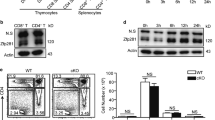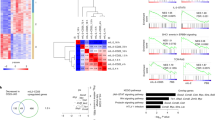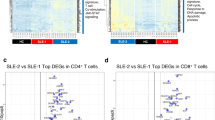Abstract
Activation-induced CD154 expression on CD4 T cells is prolonged in systemic lupus erythematosus, but the mechanism(s) for its dysregulation are unknown. The studies reported herein demonstrate that interleukin-15 (IL-15) is capable of prolonging CD154 expression on phytohemagglutinin (PHA)-activated CD4 T cells. As IL-15 signals through signal transducer and activator of transcription 5 (STAT5), predicted STAT5 binding sites in the human CD154 transcriptional promoter were identified, and STAT5 binding to the proximal CD154 promoter in vitro and in vivo following primary CD4 T-cell activation was demonstrated. Moreover, overexpression of wild-type STAT5 in primary human CD4 T cells augmented CD154 transcription, whereas overexpression of a dominant-negative (DN) STAT5 protein inhibited CD154 transcription. Mutation of the most proximal STAT5 binding site in the CD154 promoter resulted in diminished DNA binding and reduced CD154 transcriptional activity. Interestingly, STAT5-specific small interfering RNA inhibited CD154 surface expression at 48 but not 24 h after T-cell activation. Thus, these findings provide some of the first evidence to support a possible mechanistic link to explain how the overexpression of IL-15 observed in lupus patients may be involved in the prolonged expression of CD154 that has also been observed on lupus CD4 T cells.
This is a preview of subscription content, access via your institution
Access options
Subscribe to this journal
Receive 6 digital issues and online access to articles
$119.00 per year
only $19.83 per issue
Buy this article
- Purchase on Springer Link
- Instant access to full article PDF
Prices may be subject to local taxes which are calculated during checkout








Similar content being viewed by others
References
Cron RQ . CD154 transcriptional regulation in primary human CD4 T cells. Immunol Res 2003; 27: 185–202.
Cron RQ . CD154 and lupus. Pediatr Rheumatol Online J 2003; 1: 172–181.
Yi Y, McNerney M, Datta SK . Regulatory defects in cbl and mitogen-activated protein kinase (extracellular signal-related kinase) pathways cause persistent hyperexpression of CD40 ligand in human lupus T cells. J Immunol 2000; 165: 6627–6634.
Baranda L, de la Fuente H, Layseca-Espinosa E, Portales-Perez D, Nino-Moreno P, Valencia-Pacheco G et al. IL-15 and IL-15R in leucocytes from patients with systemic lupus erythematosus. Rheumatology (Oxford) 2005; 44: 1507–1513.
Waldmann TA, Tagaya Y . The multifaceted regulation of interleukin-15 expression and the role of this cytokine in NK cell differentiation and host response to intracellular pathogens. Annu Rev Immunol 1999; 17: 19–49.
Tagaya Y, Bamford RN, DeFilippis AP, Waldmann TA . IL-15: a pleiotropic cytokine with diverse receptor/signaling pathways whose expression is controlled at multiple levels. Immunity 1996; 4: 329–336.
Schmitt-Ney M, Doppler W, Ball RK, Groner B . Beta-casein gene promoter activity is regulated by the hormone-mediated relief of transcriptional repression and a mammary-gland-specific nuclear factor. Mol Cell Biol 1991; 11: 3745–3755.
Lieberman LA, Tsokos GC . The IL-2 defect in systemic lupus erythematosus disease has an expansive effect on host immunity. J Biomed Biotechnol 2010; 2010: 740619.
Park YB, Kim DS, Lee WK, Suh CH, Lee SK . Elevated serum interleukin-15 levels in systemic lupus erythematosus. Yonsei Med J 1999; 40: 343–348.
Aringer M, Stummvoll GH, Steiner G, Koller M, Steiner CW, Hofler E et al. Serum interleukin-15 is elevated in systemic lupus erythematosus. Rheumatology (Oxford) 2001; 40: 876–881.
Clark DN, Markham JL, Sloan CS, Poole BD . Cytokine inhibition as a strategy for treating systemic lupus erythematosus. Clin Immunol 2013; 148: 335–343.
Chae DW, Nosaka Y, Strom TB, Maslinski W . Distribution of IL-15 receptor alpha-chains on human peripheral blood mononuclear cells and effect of immunosuppressive drugs on receptor expression. J Immunol 1996; 157: 2813–2819.
Matys V, Kel-Margoulis OV, Fricke E, Liebich I, Land S, Barre-Dirrie A et al. TRANSFAC and its module TRANSCompel: transcriptional gene regulation in eukaryotes. Nucleic Acids Res 2006; 34: D108–D110.
DaSilva L, Rui H, Erwin RA, Howard OM, Kirken RA, Malabarba MG et al. Prolactin recruits STAT1, STAT3 and STAT5 independent of conserved receptor tyrosines TYR402, TYR479, TYR515 and TYR580. Mol Cell Endocrinol 1996; 117: 131–140.
Mayr S, Welte T, Windegger M, Lechner J, May P, Heinrich PC et al. Selective coupling of STAT factors to the mouse prolactin receptor. Eur J Biochem 1998; 258: 784–793.
Selliah N, Zhang M, DeSimone D, Kim H, Brunner M, Ittenbach RF et al. The gammac-cytokine regulated transcription factor, STAT5, increases HIV-1 production in primary CD4 T cells. Virology 2006; 344: 283–291.
Ahonen TJ, Xie J, LeBaron MJ, Zhu J, Nurmi M, Alanen K et al. Inhibition of transcription factor Stat5 induces cell death of human prostate cancer cells. J Biol Chem 2003; 278: 27287–27292.
Schubert LA, King G, Cron RQ, Lewis DB, Aruffo A, Hollenbaugh D . The human gp39 promoter. Two distinct nuclear factors of activated T cell protein-binding elements contribute independently to transcriptional activation. J Biol Chem 1995; 270: 29624–29627.
Koshy M, Berger D, Crow MK . Increased expression of CD40 ligand on systemic lupus erythematosus lymphocytes. J Clin Invest 1996; 98: 826–837.
Desai-Mehta A, Lu L, Ramsey-Goldman R, Datta SK . Hyperexpression of CD40 ligand by B and T cells in human lupus and its role in pathogenic autoantibody production. J Clin Invest 1996; 97: 2063–2073.
Skov S, Bonyhadi M, Odum N, Ledbetter JA . IL-2 and IL-15 regulate CD154 expression on activated CD4 T cells. J Immunol 2000; 164: 3500–3505.
Mottonen M, Isomaki P, Luukkainen R, Toivanen P, Punnonen J, Lassila O . Interleukin-15 up-regulates the expression of CD154 on synovial fluid T cells. Immunology 2000; 100: 238–244.
Zhang Y, Zhao M, Sawalha AH, Richardson B, Lu Q . Impaired DNA methylation and its mechanisms in CD4(+)T cells of systemic lupus erythematosus. J Autoimmun 2013; 41: 92–99.
Lu Q, Wu A, Tesmer L, Ray D, Yousif N, Richardson B . Demethylation of CD40LG on the inactive X in T cells from women with lupus. J Immunol 2007; 179: 6352–6358.
Chen T, Li Z, Jing T, Zhu W, Ge J, Zheng X et al. MicroRNA-146a regulates the maturation process and pro-inflammatory cytokine secretion by targeting CD40L in oxLDL-stimulated dendritic cells. FEBS Lett 2011; 585: 567–573.
Cron RQ, Bort SJ, Wang Y, Brunvand MW, Lewis DB . T cell priming enhances IL-4 gene expression by increasing nuclear factor of activated T cells. J Immunol 1999; 162: 860–870.
Schreiber E, Matthias P, Muller MM, Schaffner W . Rapid detection of octamer binding proteins with ‘mini-extracts’, prepared from a small number of cells. Nucleic Acids Res 1989; 17: 6419.
Selliah N, Zhang M, White S, Zoltick P, Sawaya BE, Finkel TH et al. FOXP3 inhibits HIV-1 infection of CD4 T-cells via inhibition of LTR transcriptional activity. Virology 2008; 381: 161–167.
Burchill MA, Goetz CA, Prlic M, O'Neil JJ, Harmon IR, Bensinger SJ et al. Distinct effects of STAT5 activation on CD4+ and CD8+ T cell homeostasis: development of CD4+CD25+ regulatory T cells versus CD8+ memory T cells. J Immunol 2003; 171: 5853–5864.
Kirken RA, Erwin RA, Wang L, Wang Y, Rui H, Farrar WL . Functional uncoupling of the Janus kinase 3-Stat5 pathway in malignant growth of human T cell leukemia virus type 1-transformed human T cells. J Immunol 2000; 165: 5097–5104.
Behre G, Smith LT, Tenen DG . Use of a promoterless Renilla luciferase vector as an internal control plasmid for transient co-transfection assays of Ras-mediated transcription activation. Biotechniques 1999; 261: 24–26, 28.
Cron RQ, Bartz SR, Clausell A, Bort SJ, Klebanoff SJ, Lewis DB . NFAT1 enhances HIV-1 gene expression in primary human CD4 T cells. Clin Immunol 2000; 94: 179–191.
Torgerson TR, Genin A, Chen C, Zhang M, Zhou B, Anover-Sombke S et al. FOXP3 inhibits activation-induced NFAT2 expression in T cells thereby limiting effector cytokine expression. J Immunol 2009; 183: 907–915.
Brunner M, Zhang M, Genin A, Ho IC, Cron RQ . A T-cell-specific CD154 transcriptional enhancer located just upstream of the promoter. Genes Immun 2008; 9: 640–649.
Cron RQ, Bandyopadhyay R, Genin A, Brunner M, Kersh GJ, Yin J et al. Early growth response-1 is required for CD154 transcription. J Immunol 2006; 176: 811–818.
Acknowledgements
We thank Dr Michael Farrar for the kind gift of the constitutively active STAT5b plasmid (STAT5b-CA), Dr Selliah for the kind gift of the mSTAT5b plasmid and Audrey Daggan for her technical contributions. We would like to acknowledge the importance and valuable contribution of our Cell Cytometry Core at UAB, supported by P30 AR048311 and P30 AI027767 grants, in completing the experiments described in this manuscript. We would also like to acknowledge that funding for this research was provided by the Lupus Foundation (Cron), National Institutes of Health R01-AR-48527 (Cron), R21-AR-49335 (Cron), Arthritis Foundation (Lowe) and University of Alabama at Birmingham Pediatrics Child Health Research Center (Lowe).
Author information
Authors and Affiliations
Corresponding author
Ethics declarations
Competing interests
The authors declare no conflict of interest.
Rights and permissions
About this article
Cite this article
Lowe, R., Genin, A., Orgun, N. et al. IL-15 prolongs CD154 expression on human CD4 T cells via STAT5 binding to the CD154 transcriptional promoter. Genes Immun 15, 137–144 (2014). https://doi.org/10.1038/gene.2014.3
Received:
Revised:
Accepted:
Published:
Issue Date:
DOI: https://doi.org/10.1038/gene.2014.3
Keywords
This article is cited by
-
Extensive fragmentation and re-organization of transcription in Systemic Lupus Erythematosus
Scientific Reports (2020)
-
Hydroxychloroquine inhibits CD154 expression in CD4+ T lymphocytes of systemic lupus erythematosus through NFAT, but not STAT5, signaling
Arthritis Research & Therapy (2017)
-
Signal transducer and activator of transcription 5 is implicated in disease activity in adult and juvenile onset systemic lupus erythematosus
Clinical Rheumatology (2016)



